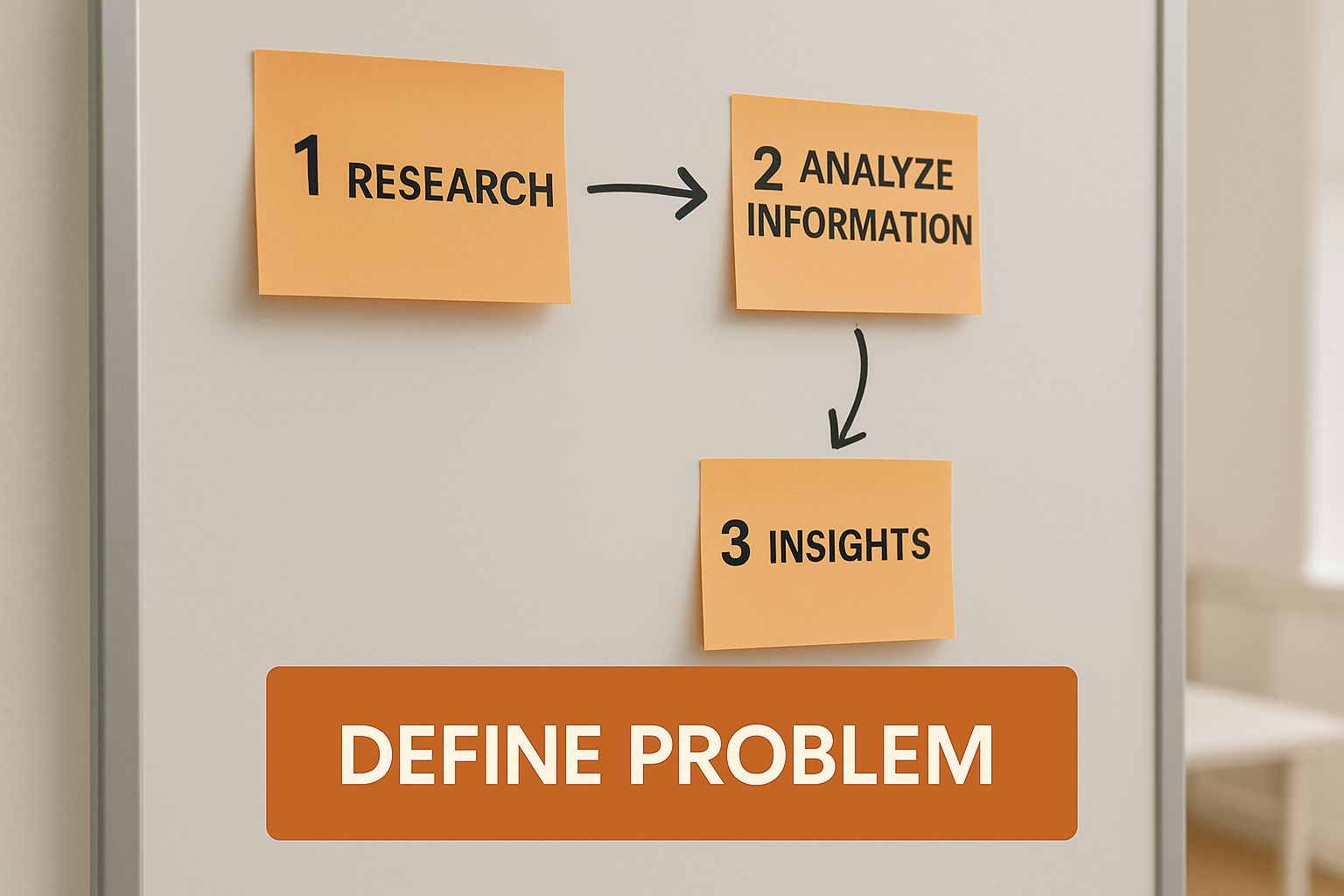If you want to find a problem worth solving with a startup, you have to start with a problem-first mindset. This means you stop thinking about solutions and start obsessing over real, urgent pain points people are struggling with. It’s about digging deep to understand where the market has gaps and proving that customers aren't just annoyed—they're desperate enough to pay for a fix.
Frankly, this is the single most critical step in building a business that actually lasts.
Why a 'Problem-First' Mindset Is Non-Negotiable
Every great startup I've ever seen or studied began with a relentless focus on a painful problem, not a clever idea. It's a classic trap, especially for indie hackers and solopreneurs, to fall in love with a solution first. They build a beautiful, elegant product that, unfortunately, no one really needs. This is what we call building a solution in search of a problem, and it's a direct path to burning through your time and money.

The old advice to "solve your own problem" isn't bad—it’s a decent starting point. But it can also be a dead end if you're the only one with that problem. A truly scalable business is built on a pain shared by a much larger group of people. This requires a mental shift. You need to stop acting like an inventor and start thinking like a detective.
The Dangers of Building a 'Solution in Search of a Problem'
The startup graveyard is filled with beautifully engineered products that failed because they solved a problem no one cared about. These cautionary tales almost always share a few things in common:
- Assuming a need exists: The founder was so convinced their idea was brilliant they never bothered to check if anyone else agreed.
- Focusing on features, not feelings: They got caught up in building "cool" new functionalities instead of addressing the user's core frustration.
- Ignoring the 'willingness to pay' signal: They built a nice-to-have for a minor inconvenience, not a must-have for a "hair-on-fire" problem people would gladly pay to extinguish.
This is exactly why a systematic, almost scientific, approach is so crucial. A good research methodology treats a problem like a doctor diagnosing an illness—it requires careful observation, testing, and comparison to find the right cure. This process forces you to frame the problem so clearly that potential solutions almost design themselves. For a deeper, academic look at this, you can explore the principles of problem formulation in research.
A problem isn't truly a problem until someone is willing to pay to make it disappear. Your goal isn't just to find a minor annoyance; it's to find a pain so sharp that your solution becomes an immediate, no-brainer purchase.
When you adopt a problem-first mindset, you’re forced to become an expert on your customer's world. You learn their language, their workflows, and the exact moments where things go wrong for them. That deep sense of empathy is the foundation of every great product. It dictates not just what you build, but how you build it, market it, and ultimately, sell it.
In the end, finding the problem is finding your business.
Where to Find Problems: The Reddit Goldmine
You can't just dream up a startup idea in a vacuum. The most successful products aren't born from a flash of genius; they're unearthed by digging into the real-world frustrations people already have.
And where do people go to vent? Online communities. Reddit, in particular, is a raw, unfiltered goldmine for indie hackers and solopreneurs. The trick is to stop scrolling like a consumer and start scanning like a founder. You have to become a problem hunter.
This means you’re actively searching for the language of frustration. Keep your eyes peeled for posts starting with “Does anyone else struggle with…?” or comments like, “I wish there was a tool that could…” These aren't just complaints; they're signals. They're raw, unfiltered needs coming directly from the people you might one day call customers.
Zeroing In On the Right Communities
Of course, not all online hangouts are created equal. The key is to find the specific subreddits where your target audience lives and breathes. If you're passionate about building something for small business owners, your time is best spent in places like r/smallbusiness or r/entrepreneur. Thinking about a new developer tool? You'll want to be a fly on the wall in r/sysadmin or r/webdev.
For a much deeper dive into this exact strategy, our guide on conducting Reddit market research walks you through the entire process.
The old-school way of doing this involves hours of manual labor—scrolling through endless threads, copy-pasting interesting tidbits into a spreadsheet, and trying to connect the dots. It works, but it’s a grind. You have to learn to tune out the noise, separating the one-off rants from the recurring themes that hint at a much larger, unsolved problem.
This is exactly why we built ProblemSifter. Instead of you losing a weekend to manual scrolling, our tool scans the communities you care about, using AI to pinpoint discussions that explicitly mention a pain point or a wish for a new solution.
ProblemSifter does something fundamentally different from idea-generation tools. It doesn’t just give you a vague concept; it shows you the exact Reddit posts and the usernames of the people who are desperate for a solution.
This direct line to the source is invaluable. It’s the difference between guessing and knowing. You get to see the problem described in the user's own words, and you instantly have a list of people to talk to for customer interviews or to recruit for your beta launch. It turns problem discovery from an art into a science.
Popular Reddit Hubs for Problem Spotting
To get you started, here’s a look at some subreddits that are consistently rich with opportunities. Each one caters to a specific professional or hobbyist group, making them perfect hunting grounds.
Reddit Communities for Problem Discovery
| Subreddit | Audience Type | Common Problems Discussed |
|---|---|---|
| r/smallbusiness | Entrepreneurs, SMB Owners | Marketing ROI, cash flow management, hiring, finding reliable software |
| r/solopreneurs | Freelancers, Indie Hackers | Client acquisition, project management, invoicing, work-life balance |
| r/sysadmin | IT Professionals | Network monitoring, security threats, software deployment, automation scripts |
| r/PPC | Digital Marketers | Ad campaign performance, A/B testing, platform bugs, reporting tools |
| r/podcasting | Content Creators | Audio editing, monetization, audience growth, finding guests |
| r/gamedev | Game Developers | Bug tracking, asset creation, finding collaborators, marketing indie games |
These are just a handful of examples. Almost every niche, from woodworking to financial planning, has a dedicated community where people share their daily obstacles.
From a Faint Signal to a Real Opportunity
Let’s make this tangible. Imagine you’re exploring r/solopreneurs. You could manually search for keywords like "annoying" or "hate," or you could use a tool to immediately surface a thread where a dozen users are all complaining about how impossible it is to track project profitability when they use multiple payment platforms.
That’s not just a complaint anymore. That’s a powerful signal lighting up a path toward a potential micro-SaaS product.
We designed ProblemSifter with a pricing model that reflects the indie hacker ethos. Instead of another monthly subscription draining your bank account, it's a simple one-time payment for lifetime access.
For just $49, you can get lifetime access to a curated list of real startup problems people are discussing from one subreddit. Need more? Get three subreddits for $99. This approach makes genuine, data-backed problem discovery accessible to anyone with an idea and the drive to build. It takes the guesswork out of that crucial first step, freeing you up to do what you do best: build something people actually want.
From Problem Signal to Startup Concept
Alright, so you've spotted a recurring complaint on Reddit. That's a great start, but it's really just the beginning—a signal in the noise. The real work is figuring out if that signal points to a problem that can actually support a business.
Is the pain sharp enough? Is the market big enough? And here's the million-dollar question: are people so frustrated they'd actually open their wallets for a solution? Answering these questions is what separates a random idea from a genuine startup concept.
This is where a lot of founders get sidetracked. They see a validated problem and immediately jump into brainstorming solutions in a vacuum. It's a classic mistake. You risk losing touch with the very people who gave you the idea in the first place. The goal isn't just to invent something cool; it's to build something with the people already feeling the pain. That means you have to move from just lurking to direct, authentic engagement.
Turning Complaints into Conversations
The single most effective way to qualify a problem? Talk to the people who have it. This is where getting your hands on raw, unfiltered user feedback is a game-changer, especially for indie hackers and solopreneurs bootstrapping their way to success.
This whole process can be visualized as a funnel, moving from a raw signal to a refined concept.

The key here is that you need a structured approach. It's about direct validation and real engagement, not just guessing.
A tool like ProblemSifter is built for exactly this. It's different from other tools that spit out abstract, vague ideas. ProblemSifter connects you directly to the source. It doesn't just tell you what the problem is; it shows you the original Reddit post and even the usernames of the people who are struggling.
Unlike other tools, ProblemSifter doesn’t just suggest ideas—it connects you to the exact Reddit users asking for them. This shifts validation from a guessing game to a direct conversation.
This direct access is what lets you move from just thinking about an idea to targeted outreach, all in one place.
A Quick Framework for Qualifying Problems
Once you have a list of real users, you can start having real conversations to see if there's a real opportunity. Before you even think about writing a single line of code, use this access to do three things:
- Gauge the Pain Level: Reach out. Ask questions. Is this a "hair-on-fire" problem or just a minor annoyance? Pay close attention to the words they use—that's where you'll understand the emotional weight of the problem.
- Check for Willingness to Pay: This is a crucial, early test. Don't be afraid to frame the conversation around value. Ask questions like, "If a tool existed that solved this for you, what would that be worth?"
- Brainstorm and Build an Audience: Once you have a rough concept for a solution, these same people become your first focus group. Share mockups, get feedback, and start building a waitlist. This kind of targeted outreach is infinitely more effective than blasting a generic message out into the void.
This entire validation loop—from finding the signal to confirming its business potential—can be seriously streamlined. For a one-time payment of $49, you can get lifetime access to a curated list of real startup problems from a subreddit of your choice. Need more? You can get three for $99. There are no subscriptions or hidden fees. It's a tool built for builders, designed to get you from a problem to a validated concept faster than ever.
How to Validate Your Solution with Real Users
So, you’ve done the hard work. You’ve successfully pinpointed a genuine pain point that people are actually experiencing. That's a huge milestone, but the path from a validated problem to a validated solution demands just as much careful thought.
This is where so many founders stumble. They get excited, rush into development, and build a feature-packed product based on a mountain of assumptions. Don't do that. Right now, lean validation is your absolute best friend.
Your goal isn't to ship a polished product. It’s to create the most basic, bare-bones version of your solution just to see if the core concept clicks with people. This could be a simple landing page, a few mockups clicked together in a tool like Figma, or even just a well-written one-pager. The idea is to have something tangible to put in front of the very users you found earlier.
This direct connection to a real community is your secret weapon.
Getting Feedback from the Right People
Remember those Reddit usernames you collected? The ones who were openly frustrated about the very problem you're trying to solve? They are your first, and most important, focus group.
Your outreach needs to feel helpful, not salesy. Frame your message around their specific complaint.
A simple, direct message usually works best: “Hey, I saw your post about struggling with [the specific problem]. I’m actually working on a tool to fix that and was wondering if you’d be open to giving me some quick feedback on the idea.” This approach immediately shows you've done your homework and positions you as someone trying to help, not just another marketer spamming inboxes.
This is the power of closing the loop. Going from problem discovery to solution validation with the same group of people is incredibly effective, and it’s what makes a tool like ProblemSifter so valuable for indie hackers. It doesn’t just throw ideas at you; it gives you the context and the direct link to the people who need a solution.
ProblemSifter is unique because it connects you directly to the Reddit users who are literally asking for a solution. You can go straight from identifying a problem to validating your concept with the exact person who has that problem.
Start Building Your Waitlist from Day One
As you start having these conversations and sharing your early concepts, you’re doing more than just collecting feedback—you’re building your tribe of early adopters. Every single person who says, "Yes, I need this!" is a potential first customer.
Set up a simple waitlist using a free tool like Tally or Mailchimp and invite every single person you talk to. This list is pure gold. It’s a curated group of people who have:
- Confirmed they have the problem.
- Shown genuine interest in your specific solution.
- Given you permission to contact them again.
This entire process turns an abstract idea into a concrete plan backed by real, measurable user intent. You can dive deeper into these lean startup methods by exploring different ways of validating startup ideas. Following this approach ensures you’re not just building something you think is cool—you’re building something people are actually waiting for you to launch.
Choosing the Right Tools for Problem Discovery

So, how do you actually find a problem worth solving? Your approach can be as simple as a spreadsheet or as complex as a full-blown analytics suite. The tools you pick will directly impact how quickly you find insights and, frankly, how good those insights are. It’s a decision that really matters, especially when you're just starting out and every hour counts.
Lots of founders start out the old-fashioned way: manual labor. You can spend countless hours sifting through Reddit threads, copying and pasting complaints into a spreadsheet, and hoping a pattern emerges. The upside? It's free, and it forces you to get up close and personal with a community's frustrations. The massive downside is that it's a huge time sink and riddled with your own biases.
On the flip side, you have enterprise-grade market research platforms. These are powerful, no doubt, but their price tags are often astronomical for a solo founder or a small team. They give you a 30,000-foot view of the market but can easily miss the raw, authentic conversations where the real gold is usually buried.
Finding a Tool Built for Builders
This is exactly why a purpose-built tool for problem discovery can be a game-changer. General analytics tools might show you broad trends, but they often stop short of giving you something you can actually build on. A specialized tool is designed to cut through that noise and deliver actionable data, not just vague ideas.
And that distinction is everything. You don't just need to know that a problem exists. You need to know who has it and hear them describe it in their own words.
This is where a tool like ProblemSifter really shines. It was created specifically for this task. It doesn't just surface ideas; it connects you directly to the Reddit users who are practically begging for a solution. Having that direct line to your potential first customers is priceless for both shaping your idea and getting early traction.
Balancing the Books: Cost vs. Value
For most indie hackers and bootstrappers, the budget is king. This makes your choice of tooling even more critical. So many SaaS products lock you into recurring subscriptions that can bleed your bank account dry before you've even written a line of code.
This is where a straightforward pricing model becomes incredibly attractive.
- ProblemSifter's Model: You pay once for lifetime access. It's $49 for one subreddit or $99 for three. There are no subscriptions and no hidden fees.
- Typical Competitor Models: Usually involve monthly or annual fees that become a constant financial pressure while you're trying to build.
With the global economy slowing down, as the World Bank recently highlighted in its global economic outlook, founders need to make every dollar work harder. A one-time investment in a tool that directly fuels your core business idea is just smart. For founders who are focused on building, a tool like ProblemSifter offers a fast, affordable, and highly targeted path to finding the problem that could become your next big thing.
Common Questions About Finding Startup Problems
The path to finding a killer startup idea is almost never a straight line. It's messy. You'll second-guess yourself, get bogged down in research, and constantly worry you're chasing a dead end. Let's tackle some of the most common hurdles I see founders face, with some straight talk to help you get unstuck.
How Do I Know if a Problem Is Big Enough?
This is the million-dollar question, isn't it? You've found a complaint that keeps popping up, but is it a real business or just a minor annoyance for a handful of people?
The trick is to evaluate two things: the level of pain and the market size.
First, gauge the pain. Is this a "vitamin"—a nice-to-have improvement—or is it a true "painkiller"? You're looking for hair-on-fire problems. People don't think twice about paying for painkillers. Hunt for emotional, visceral language in forums and communities. When you see words like "frustrated," "hate," "impossible," or "waste of time," you're onto something.
Then, do some quick, back-of-the-napkin math to estimate market size. Who has this problem? A quick search on LinkedIn for a specific job title or checking the member count of a relevant subreddit can give you a surprisingly good first guess. If you find 10,000 people with a problem you think they'd pay $10/month to fix, you're looking at a potential $1.2 million annual recurring revenue (ARR) market. For a solo founder or a small team, that’s absolutely a business worth building.
What's the Difference Between a Real Problem and a Feature Request?
It's so easy to get distracted by suggestions for incremental tweaks while missing the gaping hole in the user's workflow. This is a classic trap.
A feature request is a small improvement on an existing solution. A real problem is a fundamental breakdown that the current solutions don't even address.
- Feature Request: "I wish this project management tool had a dark mode."
- Real Problem: "My team tracks time in one app and sends invoices from another, so I have no way to see which projects are actually profitable."
The first is a preference. The second is a business-critical blind spot that costs real money. You can get a better feel for this by looking at different customer pain points examples. Always focus on the core problem, and you’ll build something people can't live without, not just another nice-to-have feature.
A great problem isn't just about what's missing; it's about the negative consequences of its absence—wasted time, lost money, or extreme frustration. That's where real business value is created.
Should I Target a Niche or a Broad Market?
For nearly every indie founder or bootstrapped startup, the answer is the same: start with a well-defined niche.
Going after a broad market might seem like the bigger opportunity, but it's a mirage. You'll be up against giants with huge budgets, and your marketing will be too generic to resonate with anyone. It’s a recipe for burning through cash with little to show for it.
A niche, on the other hand, lets you become the big fish in a small pond. This focus is a superpower.
- You can develop deep expertise in your users' specific needs.
- Your marketing can be hyper-targeted and speak directly to their pain.
- You can completely dominate a specific community or set of keywords.
In an uncertain economy, a niche focus is also a much safer bet. As the latest OECD forecasts highlight how global trade issues can stifle broad investment, zeroing in on a specific, solvable business problem becomes a much more resilient strategy. It minimizes your risk and dramatically increases your odds of a successful launch.
Ready to stop guessing and start solving? ProblemSifter turns Reddit communities into a database of validated startup ideas, connecting you directly with the users who need your solution. Find your next startup problem today.
